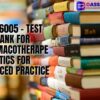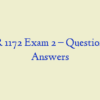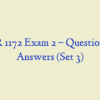Description
FIN 317 Midterm Exam (90/90 Points)
- The type of financing that occurs during the development stage of a venture’s life cycle is typically referred to as:
- Which one of the following possible conflicts of interest is usually minimized through the use of equity incentives?
- The first three stages of a successful venture’s life cycle occur in the following order:
- Mezzanine financing is associated with which one of the following life cycle stages:
- One study of successful entrepreneurs indicated that a majority felt that the most important factor in the long-term success of their ventures was:
- Determine gross profit of a venture with the following financial information: cost of goods sold = $30,000; net profit = $17,000; asset turnover = 1.6; return on assets 32%
- In the venture life cycle, moving from the development stage to the startup stage frequently begins with the preparation of a business plan. The business plan is a written document that describes the proposed venture in all of the following terms except:
- A “score” in the range of 2.34-3.00 using the VOS Indicator TM would be considered a:
- A sound business model includes a plan to:
- At the end of a qualitative-based venture opportunity screening exercise, the interviewer prepares a subjective assessment and indicates one of the following:
- The rules and procedures established to govern the corporation are called the
- Which form of business organization is characterized by having the shortest start-up time and lowest legal costs?
- In a general partnership, legal action that treats all partners equally as a group is called:
- Based on 2009 tax schedules, the first dollar of corporate income is taxed at which of the following marginal tax rates:
- Certification marks are typically used to:
- Acme Pest Control has sales of $13,500, cost of goods sold of $4,000, selling expenses of $3,500, depreciation of $2,000, interest expense of $2,000, and a tax rate of 34%.
- Cash includes all of the following except:
- Expenses or costs that vary directly with revenues are said to be:
- Which of the following is not a category on the statement of cash flows?
- Your venture has total assets of $690, net fixed assets of $500, long-term debt of $80, and stockholders’ equity of $400. What is the amount of your venture’s current liabilities?
- The difference between a venture’s ability to generate cash to pay interest and the amount of interest it has to pay is determined by which of the following ratios?
- Use the following information to determine a firm’s “cash build:” net sales = $150,000; net income = $15,000; beginning-of-period accounts receivable = $60,000; end-of-period accounts receivable = $90,000; and interest = $10,000
- Which of the following is not part of the operating cycle?
- Based on the following information, determine the venture’s cash conversion cycle: Inventory-to-sale conversion period = 112.9 days; Sale-to-cash conversion period= 57.1 days; and Purchase-to-payment conversion period = 76.8 days.
- investment bankers and commercial banks are important users of financial ratios and measures during which of the following life cycle stages?
- If a venture has a return on assets (ROA) = 12%, an equity multiplier based on beginning equity = 3.0 times, and a sustainable growth rate of 18%, the retention rate would be:
- Which one of the following life cycle stages would generally be associated with the second-lowest sales forecasting accuracy?
- Which of the following is not a step in forecasting sales for a seasoned firm?
- The financial funds needed to acquire assets necessary to support a firm’s sales growth is called:
- Determine a venture’s sustainable growth rate based on the following information: sales = $1,000,000; net income = $100,000; common equity at the beginning of the year = $500,000; and retention rate = 50%.





